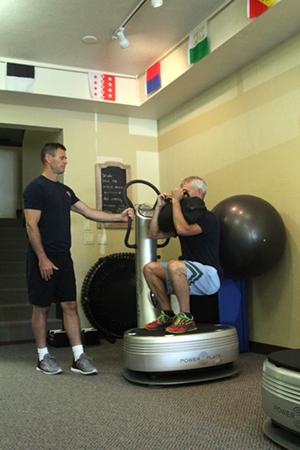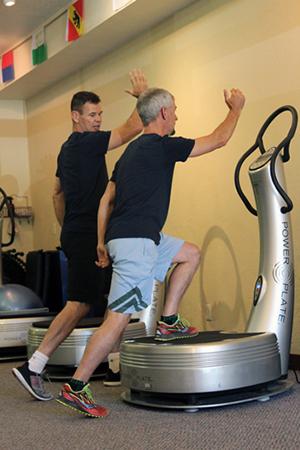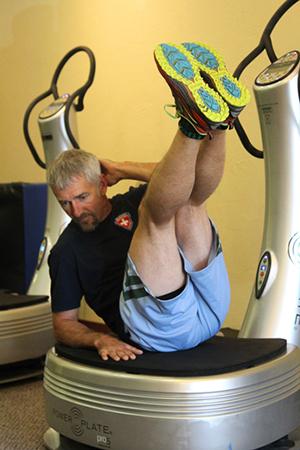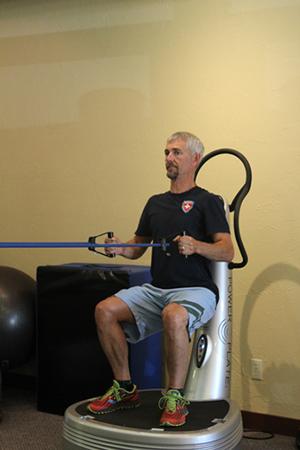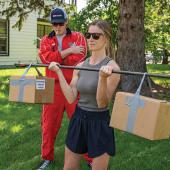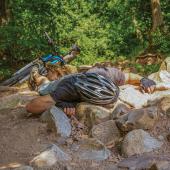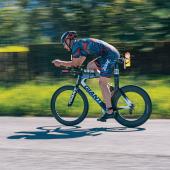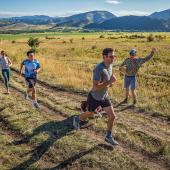Explaining Training
Q&A with Will Caton, owner of Swiss Fit Montana.
I’ll be the first to admit, when I talk with people about the workouts I’ve doing at Swiss Fit Montana, I struggle to explain the exercises, and, more importantly, how they tie in to training for the Ridge Run. So I asked Will Caton, the owner of Swiss Fit, to explain why he has me doing certain exercises.
Why all the focus on quad loading?
Well, the answer is simple: while the human body is beautifully built to climb trees and run up hills, it isn’t built for downhill work. Downhill running is horrible on the knees, and strong quads help. I use the QuadMill and dynamic wall sits on the Power Plate to aggressively activate these muscles to be their most active and powerful. The Power Plate helps to develop every muscle fiber and motor neuron in the quad system, for maximum activation on the downhill. The QuadMill helps take these highly activated muscle fibers and trains them for long downhill cycles. The two machines and exercises are a proven winning combo.
How do the Power Plate step-ups translate to climbing a mountain?
This exercise, which consists of one legged consecutive step-ups, helps the muscles to reach their maximum neuromuscular activation and strength potential. This exercise provides an active lesson in core stability, foot balance, and running mechanics. This helps the runner blast up any trail with brutal efficiency and greater endurance. Often the training will include a weight vest to increase the runner’s ability to devour uphill trails.
I’ve heard time and again how important the core is, no matter the outdoor activity. Do you work build the core in a certain way?
I train the core mid-way through the workout, with some straight abdominal moves and then when fatigue begins to set in, I’ll add in twisting core work. I want to connect the core to trail running, with all the twists, turns, and switchbacks. Switchbacks don’t occur on flats, they occur on steep climbs and descents, so a strong core, that's conditioned to twisting and helping the legs drive, is a huge advantage.
A lot of runners I know don’t do much beyond run, yet you have me building my upper body as well. What gives?
I work on shoulder strength, arm strength, and chest development. We always mix these together so that the body is use to using these muscles in unison, just like in a race. The upper body is not subject to the rigors the legs and lungs are, obviously. However, to stop short of training them shows a poor understanding of running mechanics. Nowhere is this more true than in trail running. A runner with a stronger upper body will be able to aggressively throw himself up the mountain side, helping the legs when they are reaching the end of their ability to climb.
So do you recommend strength training for runners?
It’s a long established myth that strength training is bad for distance runners. This is complete nonsense. Show me any distance runner, and I will increase his or her time with just the right amount of strength training. This is particularly true once we are past 35-40 years of age.
I fall into that category, so hopefully the work I’ve done will give me the ability to “blast up any trail with brutal efficiency and greater endurance.” My next post will hopefully be the joyful retelling of my 2016 Bridger Ridge Run domination or at least successful finish. Until then, happy trails.
Swiss Fit Montana no longer has a location in Bozeman. For more information, you can visit their website: swissfitforlife.com.


